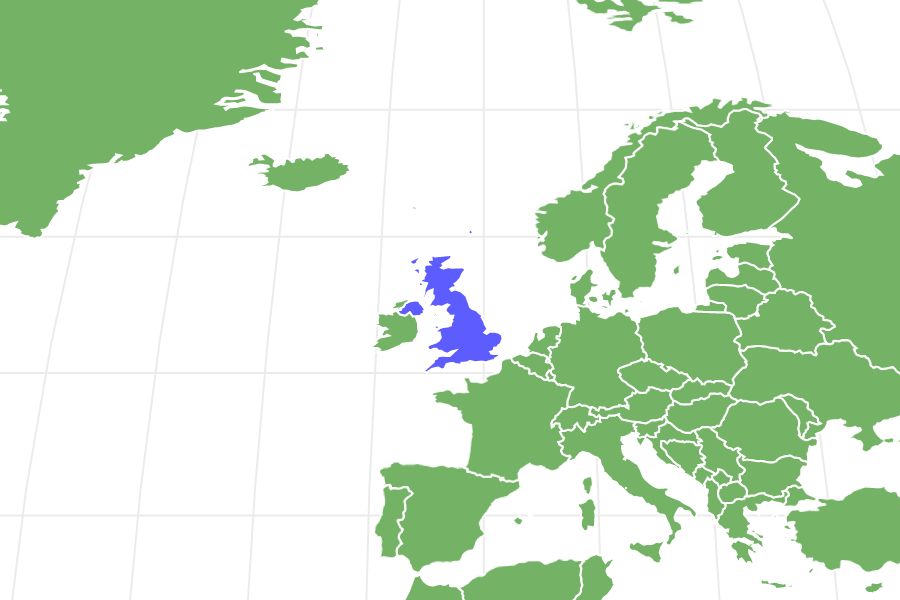Whippet
Canis lupus
Quiet, gentle and restful dogs!
Advertisement
Whippet Scientific Classification
- Kingdom
- Animalia
- Phylum
- Chordata
- Class
- Mammalia
- Order
- Carnivora
- Family
- Canidae
- Genus
- Canis
- Scientific Name
- Canis lupus
Read our Complete Guide to Classification of Animals.
Whippet Conservation Status
Whippet Facts
Whippet as a Pet:
- General Health
- Energy Level
- Shedability
- Trainability
- Intelligence
- Tendency to Chew
- Size
- Family and kid friendliness
- Yappiness / Barking
- Low
- Separation Anxiety
- Moderate
- Preferred Temperature
- Warm climate
- Exercise Needs
- Moderate
- Friendly With Other Dogs
- High
- Pure bred cost to own
- $1,200
- Dog group
- Hound
- Male weight
- 25-40 lbs
- Female weight
- 20-35 lbs
This post may contain affiliate links to our partners like Chewy, Amazon, and others. Purchasing through these helps us further the A-Z Animals mission to educate about the world's species.
View all of the Whippet images!
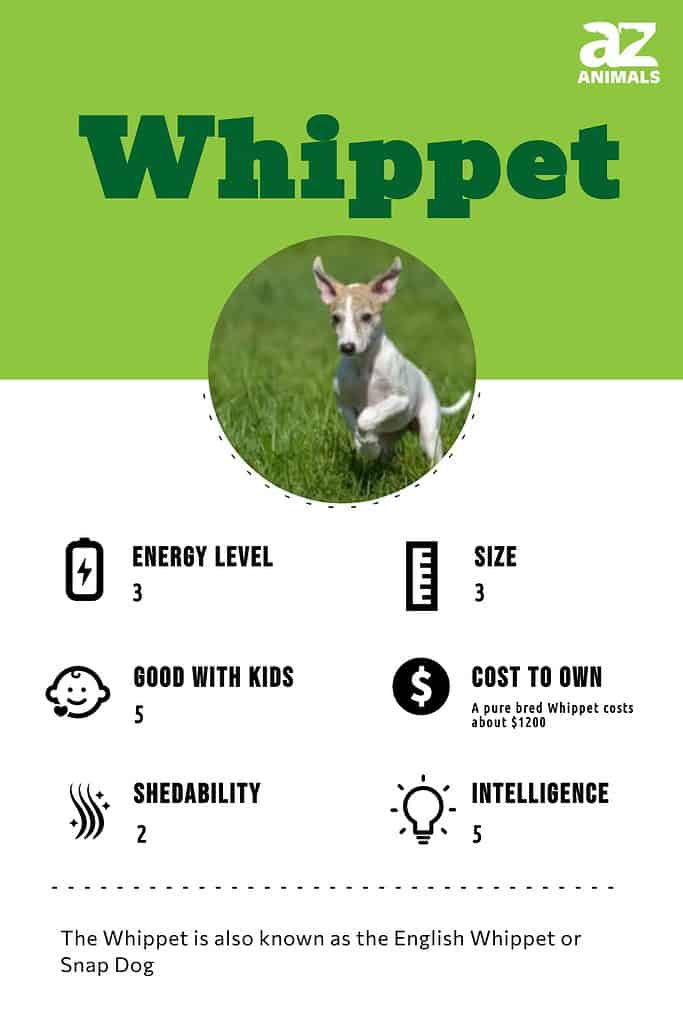
The Whippet, also known as the English Whippet or Snap Dog, is the fastest dog of its weight with the ability to reach speeds of up to 35mph.
The medium-sized breed is also called the “Poor Man’s Racehorse” and “Lightning Rag Dog.” Although it is thought of as a small Greyhound, it has a unique deep chest and slim waist, and it is not known which breed was used to create the Whippet. Bred in Victorian England for coursing in rabbit hunting, the Whippet was later used for lure coursing, amateur racing, and dog shows, and eventually made its way with the coal miners to New England. The quiet, gentle, affectionate, and intelligent breed makes an excellent family pet or city companion.
See all of our expert product reviews.
3 pros and cons of owning Whippets
| Pros! | Cons! |
|---|---|
| They’re good watchdogs. Also called a Snap Dog, its name comes from the older English word “whappet,” meaning “a small dog that yaps.” While the breed is quiet, it does have a hunting instinct that will make it bark to alert its owner of creatures outside or the doorbell ringing. | They have a strong prey drive. As sighthounds, their natural instinct is to chase anything moving on sight. They shouldn’t be taken off their leads, even if they have had obedience training. |
| They are very friendly and affectionate. They are so easygoing that they get along with children, visitors, and other dogs. The exception is cats unless they’ve been raised with one. | They are quiet but need exercise. Don’t let the couch-potato habit fool you, this breed needs a yard to run around in. If bored, they will become destructive. |
| They don’t shed much. Whippets are one of the lowest-shedding breeds around. Although their fur is spiky, regular vacuuming of furniture and carpet is all an owner needs to do. | They are thin-skinned. Not personality-wise, but literally. Not only do they get cold easily, but their short coat offers no protection against abrasions. |
Evolution and Origins
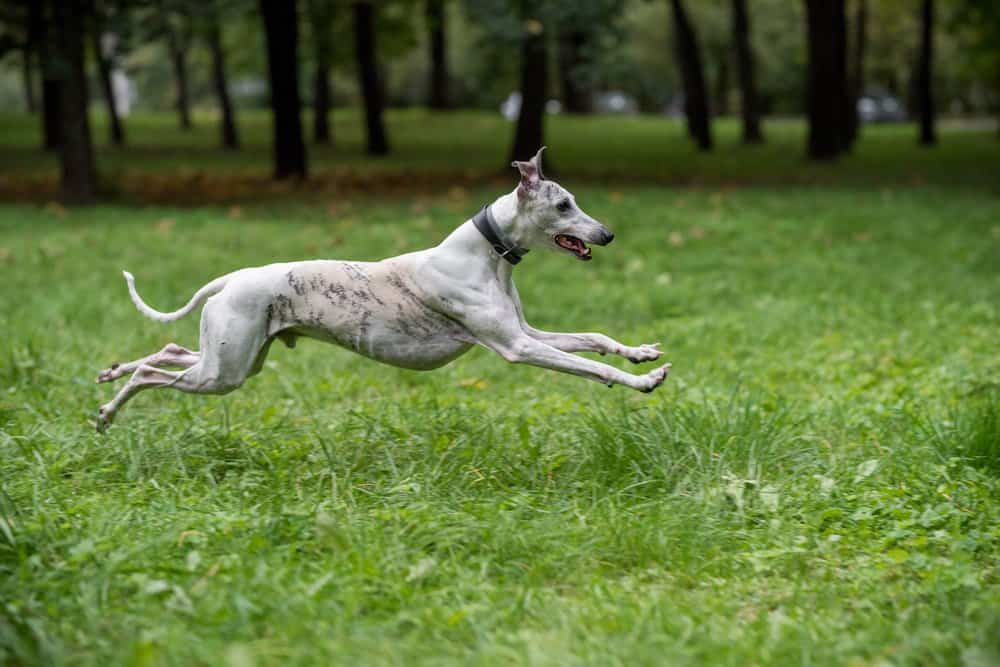
Whippets are capable of reaching 35 mph.
©photosounds/Shutterstock.com
For centuries, the Greyhound has been the model for other fast-running sighthounds, and the gentle Whippet is a successful descendant. The breed originated in England during the Victorian era when coal miners in the north of the country enjoyed dog racing and rabbit hunting in their free time. Since they could not afford to maintain large Greyhounds or have the room to exercise them properly, the miners developed a smaller version of the breed. The exact breeds used to produce the Whippet are unknown, but the result was effective: it can run at speeds up to 35 miles per hour, making it the fastest breed of its size.
In the past, the Whippet breed was called the “Poor Man’s Racehorse” and the “Lightning Rag Dog” because they would chase a rag along a straight track. The name Whippet likely came from the word “whappet,” which means a small barking dog. At the start of the 20th century, textile workers from Lancashire moved to New England and brought their Whippets with them, and this breed quickly became popular in America. People from all backgrounds enjoyed racing Whippets for fun or money, and the American Kennel Club registered its first Whippet in 1888. Nowadays, lure coursing is used to satisfy the Whippet’s need for speed.
Size and Weight
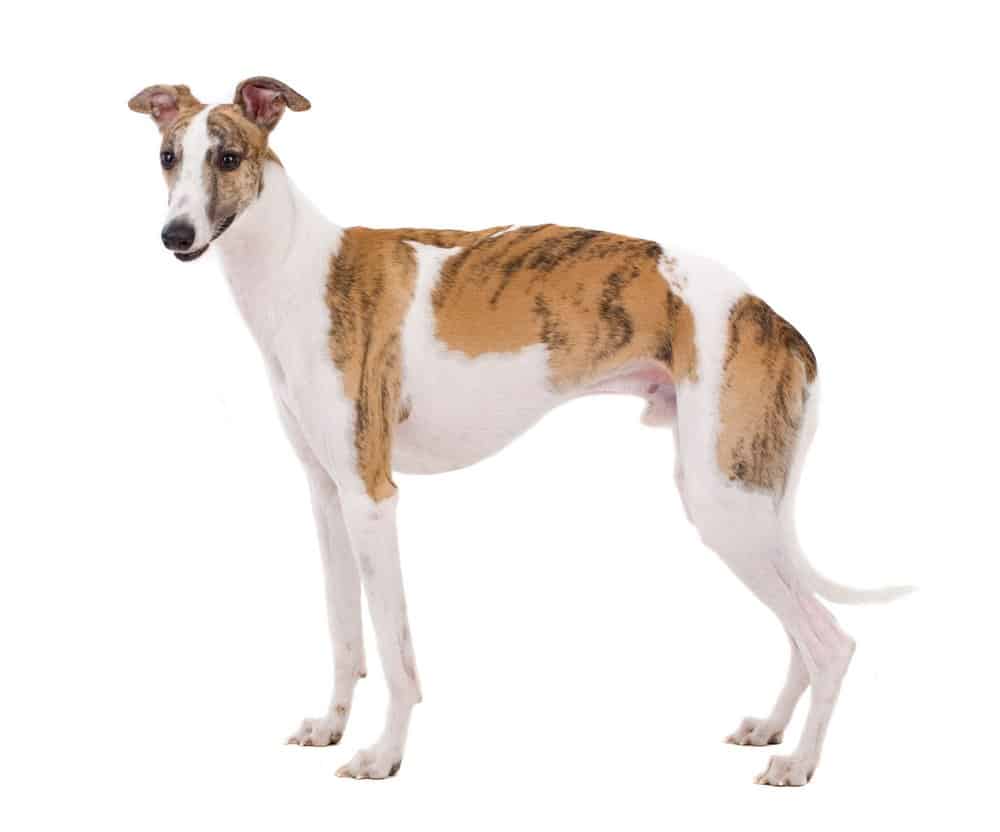
Whippets reach their full size at 14 months.
Health and Entertainment for your Whippet
See all of our expert product reviews.
©Lebedinski Vladislav/Shutterstock.com
The Whippet is a medium-sized short-haired dog with an average height of 21″ for males and 20″ for females. Males weigh about 34 pounds fully grown, while females weigh 29 pounds fully grown. Whippet puppies weigh 5.5 pounds on average at 12 weeks of age and are considered fully grown at 14 months.
| Male | Female | |
|---|---|---|
| Height | 21″ | 20″ |
| Weight | 34lbs, fully grown | 29lbs, fully grown |
Health Issues
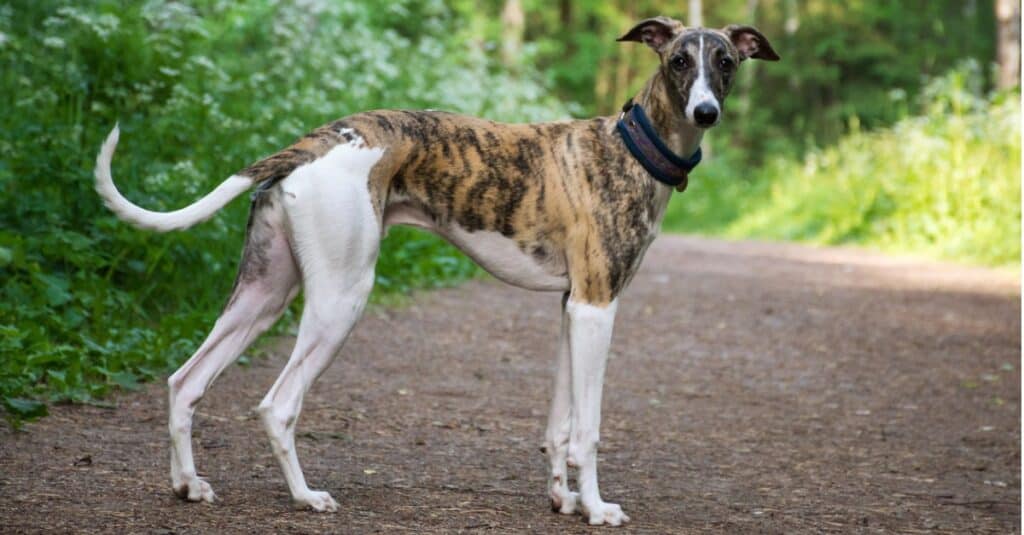
Whippets are known to enjoy robust health but are prone to cardiac issues.
©iStock.com/Natalia Timchenko
These dogs have excellent health due to their breeding for coursing, working, and racing, activities that combine to provide well-rounded physical exertion. As a result, they are not prone to many of the conditions that the Greyhound and other sighthounds and purebreds have. Genetic eye defects, hip dysplasia, congenital deafness, and hypothyroidism rarely occur.
Cancer and cardiac problems are the two top leading causes of death, followed by epilepsy and autoimmune hemolytic anemia. Whippets are also prone to chronic diarrhea due to stress, food intolerance, colitis, or bloat. All sighthounds have low body fat and are extra sensitive to anesthesia, particularly barbiturates, and require an experienced vet to follow the Sighthound Anesthesia Protocol. In short, the top health issues for Whippets are:
- Digestive problems
- Cancer
- Cardiac problems
- Epilepsy
Temperament

Whippets are laidback, patient, and easygoing
©iStock.com/BiancaGrueneberg
The temperament of these dogs is laidback and nonobtrusive. It has an affectionate personality. As a snap dog bred by the English to have similar traits to the Greyhound without the large size, its intelligence, obedience, and athletic body enabled it to learn a variety of tasks. It is relatively easy to train but with an independent streak and a strong prey drive that makes it given to chasing.
In the home, however, it only needs moderate amounts of exercise and stimulation to avoid boredom and destructiveness. It also enjoys the company of other dogs, and as it can experience separation anxiety, it is helpful to have another dog for its company while the family is gone. The Whippet only barks as a warning and rarely whines, sighs, or growls.
Care
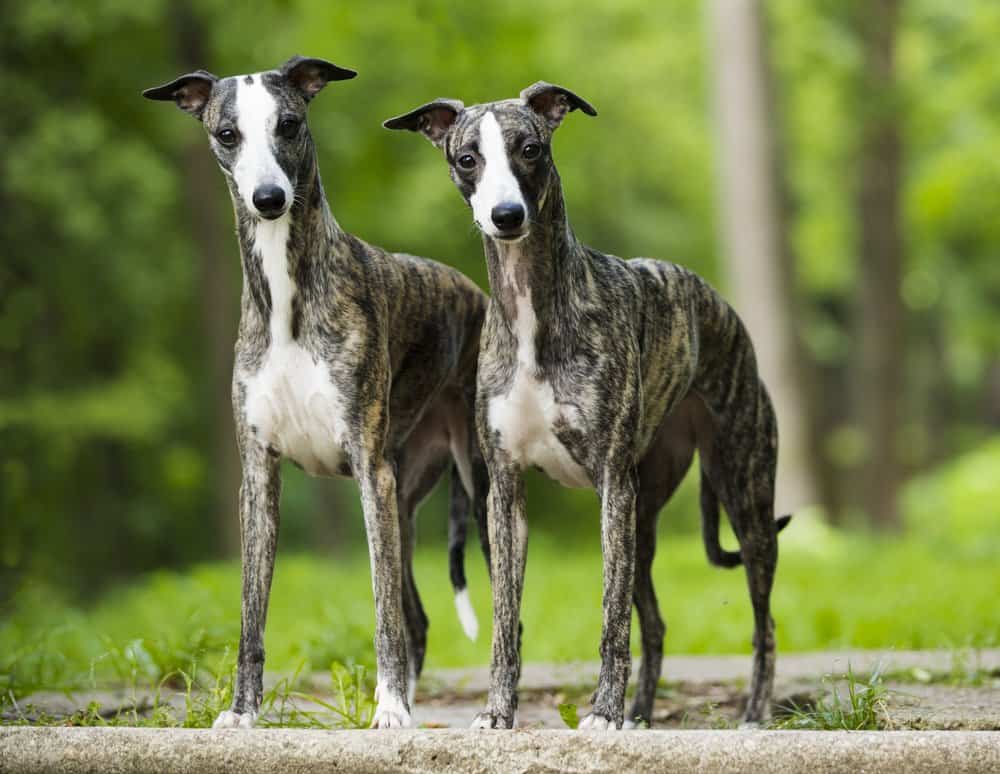
Whippets are an excellent choice for first-time dog owners
©Liliya Kulianionak/Shutterstock.com
These are medium-sized dogs who are unique in their skin sensitivities and emotional and physical needs. They make great dogs for first-time dog owners or families as they are very social and seem to grow more quickly than many other breeds. They are also good for people who live in apartments or small houses.
The Best Dog Food
The puppies are as active and demanding as puppies of other breeds but more sensitive digestion-wise. When they mature, they calm down and have different dietary needs. Remember that whippets are naturally thin dogs, so weight gain is harmful to their lean frame.
Whippet puppy food: If you’re getting your puppy from a breeder, you should gradually change it to the new food within a week. It will need high-quality puppy food made specifically for the breed. Dry or wet food is fine, but during puppyhood, whippets should be fed 3-4 meals a day for a total of 990 calories. Continue to feed them puppy food until they reach 90% of their adult size.
Whippet adult dog food: When the dog has reached a year old, you should feed them twice a day. It needs an ounce of food for every two pounds of weight for a total of 894 calories. As older whippets remain active, seek out an active adult dog food or an adult dog food made just for whippets. Grain-free, gluten-free, and raw diets are possibilities for reducing digestive issues.
A-z Animals recommends Merrick Backcountry Raw Infused Healthy Grains Dry Dog Food as the best dog food for Whippets.
This less processed raw dog food is ideal for this breed due to its digestive support, with high-protein lamb and rabbit, plus nutritious whole grains. There are no dangerous legumes such as peas and lentils. Instead, the taurine nourishes the heart to keep on ticking. Additionally, the natural amino acids lend themselves to strong immunity.
Check out Merrick Backcountry Raw Infused Healthy Grains Dog Food on Chewy and Amazon.
- Freeze-dried raw coated kibble and raw pieces
- Beef, lamb, and rabbit with wholesome grains
- No peas or lentils
Maintenance And Grooming
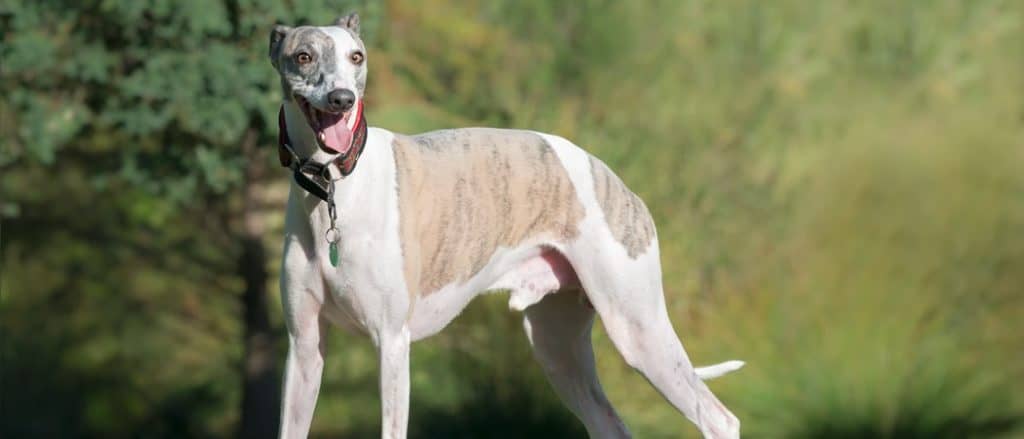
Whippets are low-maintenance but require additional warmth during
©tsik/Shutterstock.com
Whippets do not shed much except during Spring and Autumn when they change their coats. They only need a weekly brushing. For the home, you only need to keep up with regular cleaning as usual to remove the spiky fur left behind. They are very low-maintenance, but during the winter or for older dogs with arthritis, they need sweaters for warmth and comfort. Although they are not hypoallergenic, they do not tend to trigger people with asthma or allergies.
Training
Whippets are very intelligent, but they do have an independent streak, so you can expect some rebellion. Being sighthounds, they have a strong prey drive to chase anything moving that they see, so even with obedience training, they shouldn’t be taken off their leads. They also see cats as prey animals to chase unless they are mature or have been raised with a cat. Compared to other breeds, they are very obedient and intelligent and relatively easy to train. They are very sensitive and a little stubborn, so they respond well only to positive, calm training methods that focus on praise and food.
Exercise
Whippets can do with an apartment or small home as long as they have a fenced-in yard to run around in. They also need toys and games. When left alone for hours at a time, they need to be kept stimulated, so they don’t become destructive or have separation anxiety. Barring that, they need another dog for companionship. They are given to bouts of sprinting, after which they will happily collapse onto the sofa or bed with the family. The adult Whippet needs about 40 minutes of exercise with several chances to run. The breed also enjoys mental stimulation with games.
Puppies
Whippet puppies need free play like any other puppy, meaning that it shouldn’t be too strenuous while they’re still growing. A 3-month-old needs 15 minutes of play twice a day. Puppyhood is also a great time to start obedience training and socialization. Without enough early socialization, whippet puppies can become fearful and timid.
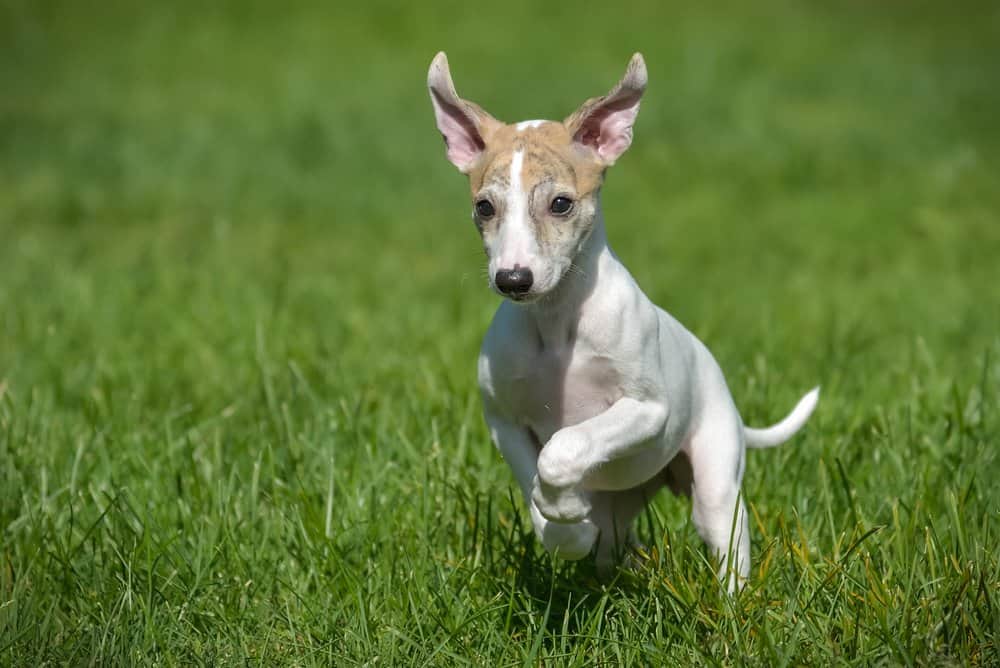
©Radek Havlicek/Shutterstock.com
With Children
Whippets are excellent with children. Perhaps the most important trait Whippets have that allows them to get along so well with children is patience. The dogs are also gentle, quiet, and calm. They also get along well with other dogs and even strangers.
Similar Dogs
Other dog breeds similar to Whippets include the Weimaraner, the Dalmatian, and the Jack Russell Terrier.
- Greyhound – The larger ancestor of the Whippet, the Greyhound runs faster and has a shorter lifespan.
- Italian Greyhound: The smallest compared to the Greyhound and Whippet, the Italian Greyhound is a toy breed meant for companionship rather than hunting.
- Whippet Hound Mix: The mix is commonly a cross between a Whippet and Doberman (called the Whipperman), but other hybrids include Labrador Retriever (Whipador), Golden Retriever (Golden Whiptriever), Pit Bull (PitWhip), Pit Bull Terrier (Pippet) and many other purebred mixes.
Whippet vs. Greyhound
There are a few key differences between the Whippet and Greyhound. The first is size, with the Whippet being medium-sized and the Greyhound large. Another is running speed; the Whippet can reach 35mph, while the Greyhound can reach 40-45mph. Lastly is lifespan; the Whippet lives 12-15 years, while the Greyhound lives 10-12 years.
Famous Whippets
A Whippet named Jim had a central role in a canal travel book trilogy by Terry Darlington in which he was described as a “narrow dog.” Hence, his name was in the books’ titles of Narrow Dog to Carcassonne, Narrow Dog to Indian River, and Narrow Dog to Wigan Pier.
Popular Names
Popular names for Whippets include:
- Devo
- Lucky
- Scout
- Roxy
- Luna
Whippet FAQs (Frequently Asked Questions)
What is a whippet?
A Whippet is essentially a smaller version of a Greyhound.
How fast can a whippet run?
A whippet can reach a speed of 35mph.
Are whippets good pets?
Whippets are excellent pets that suit a variety of homes.
Can whippets be left alone?
Whippets can be left alone without fear of destructiveness as long as they have toys to play with or another dog for companionship.
Are whippets high-energy dogs?
Whippets have bursts of high energy followed by downtime. They alternate between sprinting and resting.
How much do whippets cost to own?
Whippets cost between $1,200-2,000 with a ballpark of $800-1,500 in the eastern U.S. They cost less through adoption rather than from a breeder.
Are whippets good with kids?
Whippets are excellent with kids, but should not be left unsupervised in the event of children causing unintentional injury to the dogs.
Are whippets good with cats?
Whippets are usually not good with cats, which they consider to be small prey animals. The exception is if they are mature and have been socialized well, or are used to cats.
How long do whippets live?
12-15 years.
Are Whippets herbivores, carnivores, or omnivores?
Whippets are Omnivores, meaning they eat both plants and other animals.
What Kingdom do Whippets belong to?
Whippets belong to the Kingdom Animalia.
What phylum to Whippets belong to?
Whippets belong to the phylum Chordata.
What class do Whippets belong to?
Whippets belong to the class Mammalia.
What family do Whippets belong to?
Whippets belong to the family Canidae.
What order do Whippets belong to?
Whippets belong to the order Carnivora.
What type of covering do Whippets have?
Whippets are covered in Hair.
What genus do Whippets belong to?
Whippets belong to the genus Canis.
What is an interesting fact about Whippets?
Whippets are quiet, gentle, and restful dogs!
What is the scientific name for the Whippet?
The scientific name for the Whippet is Canis lupus.
Thank you for reading! Have some feedback for us? Contact the AZ Animals editorial team.
Sources
- Wikipedia, Available here: https://en.wikipedia.org/wiki/Whippet
- Officially Pets, Available here: https://officiallypets.com/do-whippets-shed/
- American Kennel Club, Available here: https://www.akc.org/expert-advice/lifestyle/10-things-only-a-whippet-owner-would-understand/
- Rusalka Hounds, Available here: https://rusalkahounds.com/ownership.htm
- Terrific Pets, Available here: https://terrificpets.com/articles/102149365.asp
- The Whippet, Available here: https://www.thewhippet.net/whippet_size.html
- Whippet Central, Available here: https://whippetcentral.com/is-a-whippet-a-good-first-dog/
- Your Pure Bred Puppy, Available here: https://www.yourpurebredpuppy.com/reviews/whippets.html
- 101 Dog Breeds, Available here: https://www.101dogbreeds.com/whippet-hound-mixes

